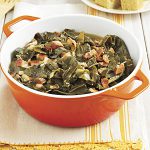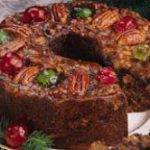
Probably no other holiday in America is more deeply entrenched in food tradition and superstition than New Year’s. While the first recorded festivities celebrating the arrival of the new year date back 4,000 years to ancient Babylon, it was Julius Caesar who originally established January 1 as the first day of the year, with the […]

This is the traditional New Year’s Day entree originated in central Pennsylvania where it’s usually served with mashed potatoes and applesauce.

In the South we prefer to cook collards low and slow in a stockpot in bacon drippings with sweet onions, chopped ham and garlic.

Hoppin’ John is so much more than just for New Year’s Eve.

A festive twist on traditional pound cake, this deliciously moist Eggnog Pound Cake takes your favorite Christmas drink and turns it into a heavenly dessert!

This recipe is for old-fashioned country-style cornbread, made without flour or sugar. Delicious!

This super easy Creamy Chocolate Fudge takes just minutes to make and is a seriously delicious, lusciously creamy, no-fail fudge!

For those folks who feel scratch-made is best, here is a wonderful chocolate fudge recipe for you.

Sometimes the simplest recipes yield the richest results.

Classic Southern Eggnog from The Country Mouse Inn in Landrum, South Carolina.

“The worst Christmas gift is fruitcake,” cracked Johnny Carson on the Tonight Show. “There is only one fruitcake in the entire world, and people keep sending it to each other, year after year.” We all hear the infamous fruitcake jokes year after year: “Why does fruitcake make the perfect gift? Because the U.S. Postal Service […]

In this recipe eliminates the candied fruits in favor of dried fruits.

What would Christmas in America be without cookies? There would be no snack for Santa, no visions of sugar plums for the children and no edible decorations for the tree. Christmas it seems was, above all other holidays, invented with cookies in mind. While Christmas cookies have been around since Medieval Europe, it was the […]

These sugar cookies are the perfect starting place for a holiday cookie decorating party.

Spritz cookies come from the German word Spritzen which means to squirt referring to the way these cookies are pushed through a cookie press to create beautiful shapes.

These delicious, fancy Christmas cookies are an elegant addition to any holiday gathering.

An easy and delicious Christmas cookie you can make using your favorite Jell-O flavor, or fusion of flavors.

After drying, these meringues get dipped in dark chocolate for a dramatic finish.

These Candy cane cookies are made with twists of green and red cookie dough flavored with fresh lemon juice.

These rich and buttery Kris Kringle Cookies are made with white chocolate chips, sweet dried cranberries and toasted pecans for the absolute best Christmas cookies found anywhere.

These decadent chewy chocolate drop cookies studded with white chocolate chunks and crunchy macadamia nuts in every bite.

Stained Glass Cookies are a Christmas classic. Sugar cookies are cut out in the shape os stars and filled with crushed Life Savers. As the cookies bake, the candy melts, creating a stained glass effect.

Swedish cookies are called sandkaker or sandbakelse actually originated in Norway. Recipes for these Scandinavian Christmas treats have been passed down from generation to generation.

These macaroons are crunchy on the outside and soft on the inside.

These gluten free Christmas cookies are a staple in German markets!

Cream cheese adds richness to these delicious Hanukkah cookies.

Whether you call it pop, soda, soda pop, or coke (a generic term), the soft drink industry in this country is huge–more than 50,000-gallons-per-American-per-year huge! By the late nineteenth century, bottled soda had come of age in America with over five hundred bottling plants producing some 260 million bottles of soda a year. In 1888, […]





























